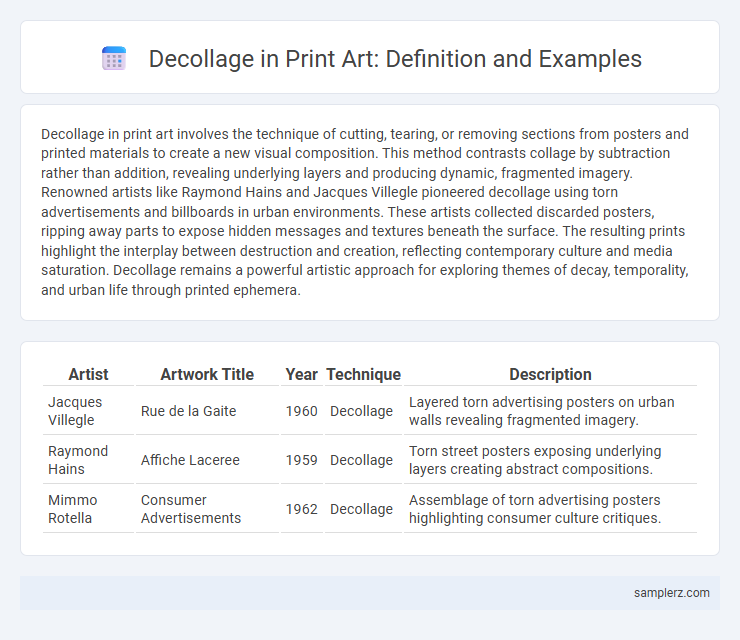Decollage in print art involves the technique of cutting, tearing, or removing sections from posters and printed materials to create a new visual composition. This method contrasts collage by subtraction rather than addition, revealing underlying layers and producing dynamic, fragmented imagery. Renowned artists like Raymond Hains and Jacques Villegle pioneered decollage using torn advertisements and billboards in urban environments. These artists collected discarded posters, ripping away parts to expose hidden messages and textures beneath the surface. The resulting prints highlight the interplay between destruction and creation, reflecting contemporary culture and media saturation. Decollage remains a powerful artistic approach for exploring themes of decay, temporality, and urban life through printed ephemera.
Table of Comparison
| Artist | Artwork Title | Year | Technique | Description |
|---|---|---|---|---|
| Jacques Villegle | Rue de la Gaite | 1960 | Decollage | Layered torn advertising posters on urban walls revealing fragmented imagery. |
| Raymond Hains | Affiche Laceree | 1959 | Decollage | Torn street posters exposing underlying layers creating abstract compositions. |
| Mimmo Rotella | Consumer Advertisements | 1962 | Decollage | Assemblage of torn advertising posters highlighting consumer culture critiques. |
Introduction to Décollage in Print Art
Decollage in print art involves the deliberate removal or tearing of layers of posters, newspapers, or printed materials to reveal underlying images and textures, creating a visually dynamic composition. This technique originated in the mid-20th century, prominently used by artists like Mimmo Rotella and Raymond Hains, who transformed urban advertising into complex artworks through collage subtraction. The process emphasizes deconstruction and fragmentation, challenging traditional print media's permanence by exposing hidden narratives beneath surface layers.
Historical Overview of Décollage Techniques
Decollage techniques emerged prominently in the mid-20th century as artists like Mimmo Rotella and Raymond Hains repurposed torn posters and urban advertisements to challenge traditional art forms. The method involves removing layers from printed materials, creating a fragmented aesthetic that contrasts with collage's additive nature. This approach not only reflects post-war cultural shifts but also highlights the transitory nature of mass media and public communication in twentieth-century art.
Famous Artists Using Décollage in Printmaking
Famous artists like Mimmo Rotella and Raymond Hains pioneered decollage in printmaking by tearing and layering posters and prints to create textured, fragmented visuals. Rotella's use of urban advertising posters emphasized the raw, spontaneous effect of decollage, while Hains combined photomontage techniques to subvert traditional imagery. These artists transformed print media into dynamic, expressive artworks that challenged conventional aesthetics in 20th-century art.
Iconic Print Décollage Artworks
Iconic print decollage artworks such as Mimmo Rotella's layered film posters reveal fragmented urban culture through torn advertisement posters. Raymond Hains' street decollage pieces transform ordinary public prints into dynamic visual narratives by peeling and reassembling billboard fragments. These works emphasize the transient nature of mass media and challenge traditional notions of print art by celebrating destruction and recomposition.
Materials and Tools for Print Décollage
Print decollage utilizes layered paper, posters, and vinyl as primary materials, often sourced from urban environments. Tools such as palette knives, scalpels, and adhesive solvents enable artists to peel and scrape layers, revealing textured surfaces and underlying imagery. This tactile manipulation creates dynamic visual narratives by fragmenting and reassembling printed media.
Step-by-Step Décollage Process in Print
Step-by-step decollage in print involves carefully layering printed materials such as posters or newspapers, then selectively cutting, tearing, or peeling sections to reveal underlying layers and create a textured, fragmented visual effect. Artists often use tools like X-Acto knives and scrapers to remove specific areas, emphasizing contrasts in color, typography, and imagery. The process highlights the tension between destruction and construction, exposing hidden narratives within the layered prints.
Contemporary Approaches to Print Décollage
Contemporary approaches to print decollage emphasize layering and deconstruction, often using torn posters, newspapers, and ephemeral materials to reveal fragmented narratives and urban textures. Artists like Mimmo Rotella and Mark Bradford manipulate surfaces to challenge traditional print permanence, creating dynamic compositions that reflect modern social and political contexts. This method revitalizes printmaking by incorporating elements of chance, impermanence, and cultural commentary into visual storytelling.
Thematic Interpretations in Décollage Prints
Decollage prints, such as Mimmo Rotella's work, often reveal layers of cultural and political commentary by tearing away fragments of posters and advertisements, exposing the tension between consumerism and urban life. Thematic interpretations in these prints explore themes of fragmentation, memory, and the transient nature of public imagery, emphasizing the contrast between creation and destruction. This method underscores how the physical act of removal becomes a metaphor for social critique and visual storytelling in contemporary art.
Comparing Décollage to Collage in Print Art
Decollage in print art involves the strategic removal or tearing away of printed layers to reveal underlying imagery, contrasting with collage, which assembles diverse printed materials onto a surface. This technique emphasizes destruction and absence to create meaning, while collage focuses on accumulation and layering of elements. Artists like Mimmo Rotella exemplify decollage by repurposing torn posters, differentiating it from the additive process seen in traditional print collages.
Collecting and Exhibiting Print Décollage
Print decollage, characterized by layers of torn or peeled paper revealing fragmented images beneath, exemplifies a dynamic form of art collection and exhibition. Museums and galleries increasingly emphasize the preservation of these tactile works to showcase the raw, ephemeral aesthetics of urban environments. Collectors prioritize provenance and the interplay of texture and imagery, highlighting the cultural narratives embedded in printed posters and advertisements.

example of decollage in print Infographic
 samplerz.com
samplerz.com